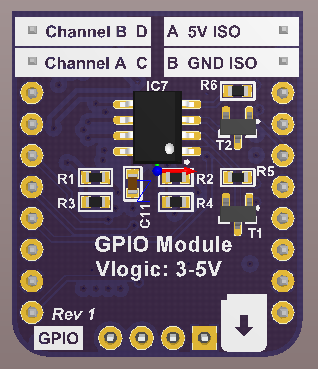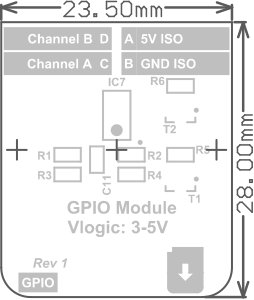GPIO Module
Schematics can be found here.
The GPIO module can be used for any signal that is 3.3V/5V, i.e. UART serial channels, I2C or just as inputs or outputs.
- Module ID: 1
- Fully isolated power and signals
- Outputs can be disconnected with a relay
- Two channels that can be set to TX/OUTPUT or RX/INPUT independently with CTRL pins
- IN_A: OUT_A - Outgoing data on channel A
- IN_B: IN_A - Incoming data on channel A
- IN_C: SWITCH - a HIGH signal switches the output relay ON and connects the outputs to the connector
- IN_D: ID - Used to set the module ID
- IN_E: CTRL_B - A HIGH signal sets channel B to an output and a LOW signal sets it to an input
- IN_F: CTRL_A - A HIGH signal sets channel A to an output and a LOW signal sets it to an input
- IN_G: OUT_B - Outgoing data on channel B
- IN_H: IN_B - Incoming data on channel B
- OUT_A: 5V isolated
- OUT_B: GND isolated
- OUT_C: CH_A_SWITCHED - The switched channel A pin
- OUT_D: CH_B_SWITCHED - The switched channel B pin
- GPIO
- UART
The board is 4 layer, 23.5x28 mm.
Homepage
Pictures
GUI Mockup
Contact
Version 2:
ui-processor-rtos
fpga-config-mcu
fpga-config-over-uart
Version 1:
freertos-serial-monitor
freertos-serial-monitor lcd test
Simple GUI:
General
GUIObject
GUIButton
GUILabel
GUIStaticTextBox
GUIAlertBox
GUIButtonGridBox
GUIButtonList
GUIInfoBox
Tasks:
LCD Task Message
LCD:
LCD ER-TFT070-4
LCD ER-TFTM070-5
LCD HY070CTP-HD
LCD HY101CTP-HD
LCD YL070MY01
Touch Controller
Measurements:
STM32 GPIO Speed
FT5206 Waveform Capture
Version 2:
Revision 2 Mockup
Module IDs
Boards:
Connection Board
UI Processor Board
Data Processor Board
Isolated Power Module
LCD Board
Modules:
1. GPIO Module
3. CAN Module
5. RS-232 Module
15. nRF24L01 Module
Future Module Ideas
FPGA:
FPGA Main Blocks
FPGA Communication
FPGA UART
FPGA GPIO
FPGA Timestamp
FPGA SDRAM
FPGA PLL
[FPGA ID Reader](https://github.com/hampussandberg/HexConnect/wiki/FPGA-ID Reader)
FPGA LVDS
FPGA Monitor
FPGA Tips and Tricks
Learning Quartus II
Version 1:
Requirement Specification
Hardware Design
Hardware Rev 1 Fixes


